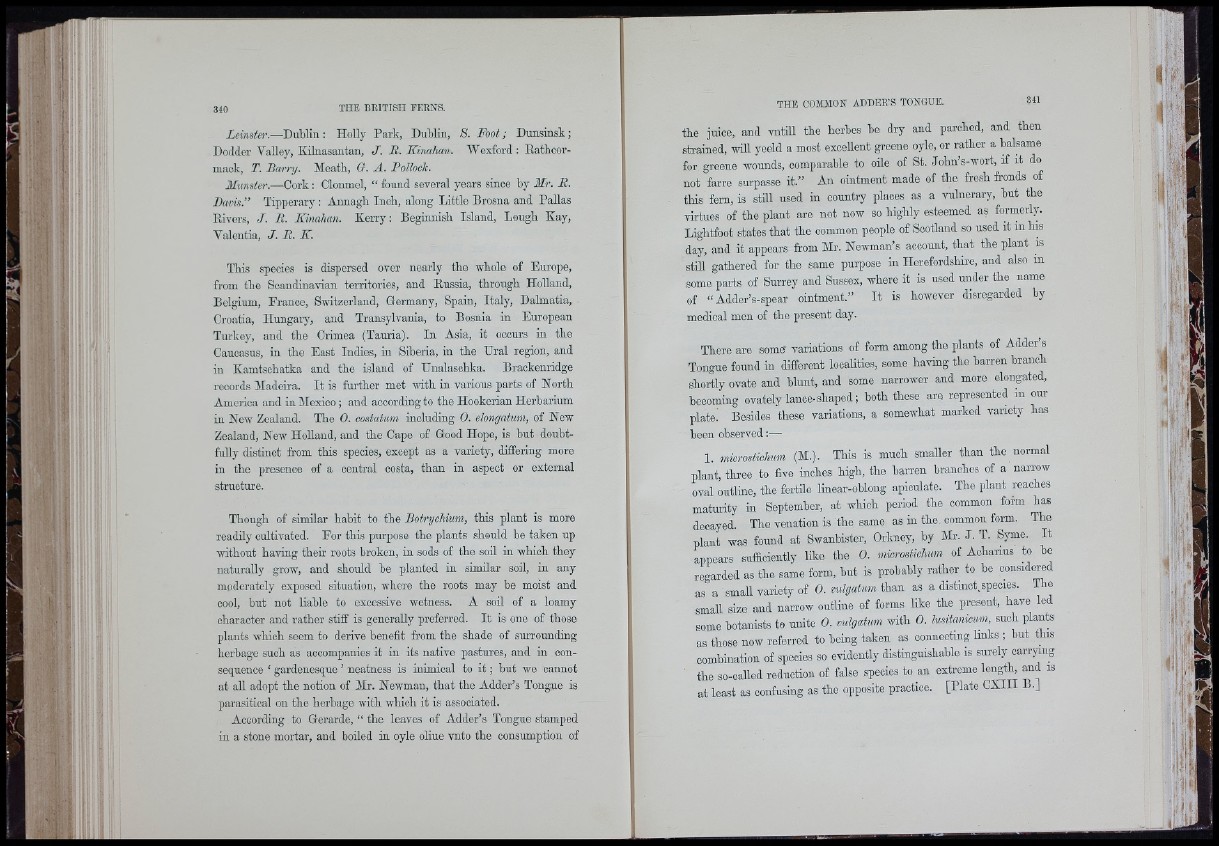
340
Lcimter.—Dublin : Holly Park, Dublin, 8. Foot ; Dunsinsk ;
Dodder Valley, KUnasantan, J. B. Kinahan. Wexford : Eathcor-
maok, T. Barry. Meatb, Q. A. Bollock.
Munster.—Cork : Clonmel, “ found several years since by Mr. B.
Bans." Tipperary : Annagb Inch, along Little Brosna and Pallas
Eivers, J. B. Kinahan. Kerry: Beginnish Island, Lough Kay,
Valentia, J. B. K.
This species is dispersed over nearly the whole of Europe,
from the Scandinavian territories, and Eussia, through Holland,
Belgium, France, Switzerland, Germany, Spain, Italy, Dalmatia,
Croatia, Hungary, and Transylvania, to Bosnia in European
Turkey, and the Crimea (Tauria). In Asia, it occurs in the
Caucasus, in the East Indies, in Siberia, in the Ural region, and
in Kamtschatka and the island of Unalaschka. Brackenridge
records Madeira. It is further met with in various parts of North
Ameiioa and in Mexico ; aud according to the Hookerian Herbarium
in New Zealand. The 0. costatum including 0. elongatum, of New
Zealand, New Holland, and the Capo of Good Hope, is but doubtfully
distmot from this species, except as a variety, differing more
in the presence of a central costa, than in aspect or external
structure.
Though of similar habit to the Botrychium, this plant is more
readily cultivated. For this purpose the plants should be taken up
without having their roots broken, in sods of the soil in which they
naturally grow, and should he planted in similar soil, in any
moderately exposed situation, where the roots may he moist and
cool, but not liable to excessive wetness. A soil of a loamy
character and rather stiff is generally preferred. It is one of those
plants which seem to derive benefit from the shade of surrounding
herbage such as accompanies it in its native pastures, and in consequence
‘ gardenesque ’ neatness is inimical to it ; but we cannot
at aU adopt the notion of Mr. Newman, that the Adder’s Tongue is
parasitical on the herbage with which it is associated.
According to Gerarde, “ the leaves of Adder’s Tongue stamped
in a stone mortar, and boiled in oyle oliue vnto the consumption of
HI;
VA
the juice, and vntill the herbes be dry and parched, and then
strained, will yeeld a most excellent greene oyle, or rather a balsame
for greene wounds, comparable to oilo of St. John’s-wort, if it do
not farre surpasse it.” An ointment made of the fresh fronds of
this fern, is still used in country places as a vulnerary, hut the
virtues of the plant are not now so highly esteemed as formerly.
Lightfoot states that the common people of Scotland so used it m his
day, aud it appears from Mr. Newman’s aooount, that the plant is
StiU gathered for the same purpose in Herefordshire, and also in
some parts of Surrey and Sussex, where it is used under the name
of “ Adder’s-spear ointment.” It is however disregarded by
medical men of tlie present day.
There are some' variations of form among the plants of Adder’s
Tongue found in different localities, some having the barren branch
shortly ovate and hlunt, and some narrower and more elongated,
becoming o v a t e l y lance-shaped; both these are represented in our
plate! Besides these variations, a somewhat marked variety has
been observed:—
1. microstichum (M.). This is much smaUer than the normal
plant, three to five inches high, the barren branches of a narrow
oval outline, the fertile linear-ohlong apioulate. Tho plant reaches
maturity in September, at which period the common form has
decayed. The venation is the same as in the. common form. The
plant was found at Swanbister, Orkney, by Mr. J. T. Syme. It
appears sufficiently Hke the 0. microstichum of Acharms to he
regarded as the same form, but is probably rather to be considered
as a small variety of 0. vulgatum than as a distinot.species. The
small size and narrow outline of forms like the present, have led
some botanists to unite 0. vulgatum with 0. lusitamcum, such plante
as those now referred to being taken as connecting links ; but this
oomhiuatiou of species so evidently distinguishable is surely carrying
' the so-oalled reduction of false species to an extreme length, and is
at least as confusing as the opposite practice. [Plate CXIII B.J
1- r«l;